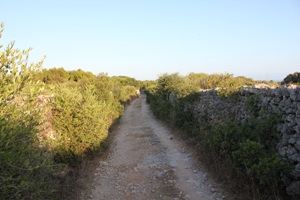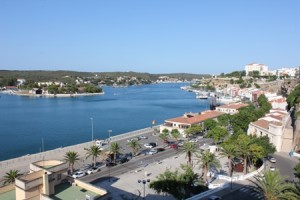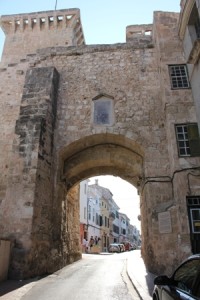My Menorca, Part II
She was an enchanted island, lost in the midst of the sea.
Her people lived their lives wedded to their tasks, knowing nothing of other lands or other skies
or other seas. Because for them there was no other world beyond their own.
From A Menorcan Romance by Gumersindo Riera
From the air, Menorca lies open like one’s palm, smooth and pink, and crisscrossed with twisting and narrow roads that appear like so many lifelines. The island, one also sees from the air, crowds its coasts. High-rises hotel complexes and sprawling urbanizations hem in rocky coves and patches of Mediterranean sand, leaving the interior landscape to a few towns, miles of low, rock walls, and isolated whitewashed farmhouses. What is new to me, arriving this summer after three decades away, are the dozens of the tall, thin white wind generators.
As I mentioned, when I first arrived in ’67 Menorca was still building its jet airport and high-rise beach hotels. There were only a handful of telephones on the island, no televisions.
Now everyone in Menorca has a phone. Everyone has a cellphone and iPads, etc. Someone publishes a monthly English magazine for the island, Roqueta. There is a Masonic Lodge, a Cricket Team and several Ladies Clubs! The English in retirement love the island. There are endless summer package tours from Europe, a new golf course, wind surfing clubs, discos, crowded summer beaches, and expensive hotels. And the new airport is big enough to get lost in.
The island, like life itself, has lost some of its charm, especially around Mahon, but there are still many of the old ways to be found behind the high gloss of developments, and some of what is new, is very good, like the network of paced roads. But one off the ‘highways’ one is back in old Menorca!
But one off the ‘highways’ one is back in old Menorca!
Where in the world is Menorca?
The island of Menorca lies in the Mediterranean, 130 miles off the coast of Spain. It is, as I wrote, the northernmost island of the Balearic archipelago. Less than 32 miles long and only nine miles wide, it has more than 100 sandy beaches, rocky coves and tiny inlets. The abundance of warm blue water beaches is the island’s greatest, but not, it’s only attraction.
Mahón/Maó
The capital, Mahón, when I first came to Menorca had a population of 25,000, half the island’s population. My guess is that the population of Greater Mahon is twice that now.
Mahon is an ancient fort-city, built by the Carthaginians high up on steep cliffs. There are still aspects of the former walled town.
There are still aspects of the former walled town.
The word “Mahón” is actually a corruption of Portus Magonis, the name of Hannibal’s brother who spent the winter of 206 B.C. in Menorca. He was on his way from the Spanish mainland to Italy, where he was bringing reinforcements to the Carthaginian armies.
Today with the regionization of Spain the island’s language, Menorquin, is standard on the island. Mahón is called Maó and nearby Villacarlos (where I first lived) is now Es Castell.
Prize of the Med
Because of its deep harbor and the island’s strategic location, Menorca has been a prize in the Mediterranean through centuries of sea warfare, and each conquering army left something behind.
Lord Nelson sailed into the port of Mahón in 1799, arriving with a squadron and seizing the Golden Farm, a red-brick mansion with a classical portico that overlooked the harbor. Some accounts say that Lady Hamilton was with him during the several months he spent on Menorca, but local historians have no record of her arrival. There is documentation, however, that Lord Nelson wrote part of his memoirs while on the island. The Golden Farm is still visible high on the cliffs overlooking the city.
In and around Menorca
Mahón has Georgian town houses and tight, narrow cobblestones streets that twist and turn through the hills, leading from one plaza to the next.
And herein lies the town’s real pleasure – to wander aimlessly about, discovering accidentally the eccentric collection of historical sights. In the Plaza Generalísimo Franco, for example, is the Baroque church of Santa María, built in 1748. Farther along a cobblestone side street is the city’s most famous ruin, a section of the medieval stone fortification walls that were erected around Mahón during the reign of King Alfonso III, who conquered Menorca in 1287.
Beyond Mahón
Most of the island’s interior is farmland. The gentle, rolling hills are dominated by large red-tile-and-whitewash houses built to overlook acres of green fields. The land has been squared off with long walls of rock, cleared from the fields and built up through centuries of manual labor. These walls stretch to all horizons in checkerboard fashion, and when you drive the narrow back roads, you feel caught in an endless maze until quite suddenly bright blue water comes into view. Every road in Menorca leads eventually to the sea and the sand.
Next, what’s right with Menorca